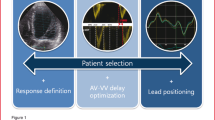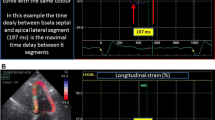Abstract
Traditional indexes of LV dyssynchrony (DYS) in pts to be resynchronized are sensitive to noise, while the concordance between LV lead position and site of latest mechanical activation is suggested to be, in these patients, clinically relevant. Both aspects, asynchrony and lead position have been addressed separately but unclear is their potential synergistic role in the clinical evolution of CRT patients. We assessed clinical and echocardiographic outcome, as well as mid-term prognosis, in a population of CHF patients submitted to CRT, stratified according to a novel asynchrony quantitation (temporal uniformity of strain: TUS) method and concordance or not between presumed LV lead position and site of latest mechanical activation. TUS was computed in 85 pts (QRS > 120 ms, EF < 0.35) in whom we measured circumferential and longitudinal strains using speckle-tracking 2D-echocardiography before and 3–6 months after CRT, together with triplane apical LV volumes. Optimal LV lead position in short axis view was defined as concordance of the segment with latest systolic circumferential strain prior-CRT and segment with assumed LV lead position. Assumed LV lead position was defined from a chest X-ray obtained 1 day after implantation and scored as anterior, lateral, posterior or inferior using 2 orthogonal views (antero-posterior and lateral). Following CRT, LV volume decreased (diastolic −8 ± 20%) and EF improved (+6 ± 9%, P < 0.001 for both). Two-way ANOVA revealed TUS improvement post-CRT (+22 ± 68%, P = 0.025), with a clear evidence for more marked asynchrony detectable at circumferential (from 0.53 ± 0.20 to 0.55 ± 0.19) as compared with longitudinal level (from 0.56 ± 0.14 to 0.62 ± 0.14) (P = 0.017). Multivariate analysis revealed that greater baseline asynchrony, as assessed circumferentially (P = 0.079), together with concordance between LV lead position and site of activation (P = 0.012), besides younger age (P = 0.051), longer QRS duration (P = 0.021) and higher baseline EF (P = 0.04),), but not longitudinal TUS (P = 0.231) did predict death from any cause or new episodes of pulmonary or systemic congestion requiring i.v. diuretics during a 529 ± 357 days clinical follow-up. We conclude that DYS indexed by circumferential TUS yields CRT benefits, supporting the idea of targeting TUS-measured DYS as the informative asynchrony quantitative measurement in CRT pts. Significant predictability in medium-term clinical follow-up of patients to be resynchronized is also associated with concordance between site of latest mechanical activation and presumed LV lead position in the present study.




Similar content being viewed by others
References
Butter C, Auricchio A, Stellbrink C et al (2001) Pacing therapy for chronic heart failure II study group. Effect of resynchronization therapy stimulation site on the systolic function of heart failure patients. Circulation 104:3026–3029
Gras D, Lechers C, Tang AS, Becknell C, Luttikhuis HO, Kirstein-Pedersen A (2002) Cardiac resynchronization therapy in advanced heart failure: the multicenter InSync clinical study. Eur J Heart Fail 4:311–320
Young JB, Abraham WT, Smith AL et al (2003) Combined cardiac resynchronization and implantable cardioversion defibrillation in advanced chronic heart failure: the MIRACLE ICD Trial. JAMA 289:2685–2694
Linde C, Braunschweig F, Gadler F, Bailleul C, Daubert JC (2003) Long-term improvements in quality of life by biventricular pacing in patients with chronic heart failure: results from the multisite stimulation in cardiomyopathy study (MUSTIC). Am J Cardiol 91:1090–1095
Wikstrom G, Blomström-Lundqvist C, Andren B et al (2009) CARE-HF study investigators. The effects of aetiology on outcome in patients treated with cardiac resynchronization therapy in the CARE-HF trial. Eur Heart J 30:782–788
Hawkins NM, Petrie MC, MacDonald MR, Hogg KJ, McMurray JJV (2008) Selecting patients for cardiac resynchronization therapy: electrical or mechanical dyssynchrony? Eur Heart J 27:1270–1281
Bleeker GB, Schalij MJ, Molhoek SG et al (2004) Relationship between QRS duration and left ventricular dyssynchrony in patients with end-stage heart failure. J Cardiovasc Electrophysiol 15:544–549
Bertola B, Rondano E, Sulis M et al (2009) Cardiac dyssynchrony quantitated by time-to-peak or temporal uniformity of strain at longitudinal, circumferential and radial level: implications for resynchronization therapy. J Am Soc Echocardiogr 22:665–671
Auricchio A, Stellbrink C, Butter C et al (2003) Pacing therapies in congestive heart failure II study group; guidant heart failure research group. Clinical efficacy of cardiac resynchronization therapy using left ventricular pacing in heart failure patients stratified by severity of ventricular conduction delay. J Am Coll Cardiol 42:2109–2116
Ypenburg C, van Bommel RJ, Delgado V et al (2008) Optimal left ventricular lead position predicts reverse remodeling and survival after cardiac resynchronization therapy. J Am Coll Cardiol 52:1402–1409
Becker M, Kramann R, Franke A et al (2007) Impact of left ventricular lead position in cardiac resynchronization therapy on left ventricular remodeling. A circumferential strain analysis based on 2D echocardiography. Eur Heart J 28:1211–1220
Serri K, Reant P, Lafitte M et al (2006) Global and regional myocardial function quantification by two-dimensional strain. J Am Coll Cardiol 47:1175–1181
Helmcke F, Nanda NC, Hsiung MC et al (1987) Color Doppler assessment of mitral regurgitation with orthogonal planes. Circulation 75:175–183
Zoghbi WA, Enriquez-Sarano M, Foster E et al (2003) American society of echocardiography. Recommendations for evaluation of the severity of native valvular regurgitation with two-dimensional and Doppler echocardiography. J Am Soc Echocardiogr 16:777–802
Gimelli A, Rossi G, Landi P et al (2009) Stress/rest myocardial perfusion abnormalities by Gated SPECT: still the best predictor of cardiac events in stable ischemic heart disease. J Nucl Med 50:546–553
Lardo AC, Abraham TP, Kass DA (2005) Magnetic resonance imaging assessment of ventricular dyssynchrony: current and emerging concepts. J Am Coll Cardiol 46:2223–2228
Helm RH, Leclercq C, Faris OP et al (2005) Cardiac dyssynchrony analysis using circumferential versus longitudinal strain. Implications for assessing cardiac resynchronization. Circulation 111:2760–2767
Knebel F, Schattke S, Bondke H et al (2008) Circumferential 2D-strain imaging for the prediction of long term response to cardiac resynchronization therapy. Cardiovasc Ultrasound 6:28–33
Norisada K, Kawai H, Tanaka H et al (2010) Myocardial contractile function in the region of the left ventricular pacing lead predicts the response to cardiac resynchronization therapy assessed by two-dimensional spleckle tracking echocardiography. J Am Soc Echocardiogr 23:181–189
Greenbaum RA, Ho SY, Gibson DG, Becker AE, Anderson RH (1981) Left ventricular fibre architecture in man. Br Heart J 45:248–2463
Aurigemma GP, Silver KH, Priest MA, Gaasch WH (1995) Geometric changes allow normal ejection fraction despite depressed myocardial shortening in hypertensive left ventricular hypertrophy. J Am Coll Cardiol 26:195–202
Yu CM, Lin H, Yang H, Kong SL, Zhang Q, Lee SW (2002) Progression of systolic abnormalities in patients with “isolated” diastolic heart failure and diastolic dysfunction. Circulation 105:1195–1201
Zhang Q, Fung JW, Yip GW et al (2008) Improvement of left ventricular myocardial short-axis, but not long-axis function or torsion after cardiac resynchronization therapy—an assessment by two-dimensional speckle tracking. Heart 94:1464–1471
Bilchick KC, Dimaano V, Wu KC et al (2008) Cardiac magnetic resonance assessment of dyssynchrony and myocardial scar predicts function class improvement following cardiac resynchronization therapy. JACC Cardiovasc Imaging 1:561–568
Suffoletto MS, Dohi K, Cannesson M, Saba S, Gorcsan J III (2006) Novel speckle tracking radial strain from routine black-and-white echo images to quantify dyssynchrony and predict response to cardiac resynchronization therapy. Circulation 113:960–968
Lim P, Buakhamsri A, Popovic ZB et al (2008) Longitudinal strain delay index by speckle tracking imaging: a new marker of response to cardiac resynchronization therapy. Circulation 118:1130–1137
Delgado V, Ypenburg C, van Bommel RJ et al (2008) Assessment of left ventricular dyssynchrony by speckle tracking strain imaging: comparison between longitudinal, circumferential, and radial strain in cardiac resynchronization therapy. J Am Coll Cardiol 51:1944–1952
Yu CM, Chau E, Sanderson JE et al (2002) Tissue Doppler echocardiographic evidence of reverse remodeling and improved synchronicity by simultaneously delaying regional contraction after biventricular pacing therapy in heart failure. Circulation 105:438–445
Bax JJ, Bleeker GB, Marwick TH et al (2004) Left ventricular dyssynchrony predicts response and prognosis after cardiac resynchronization therapy. J Am Coll Cardiol 44:1834–1840
Bleeker GB, Mollema SA, Holman ER et al (2007) Left ventricular resynchronization is mandatory for response to cardiac resynchronization therapy. Analysis in patients with echocardiographic evidence of left ventricular dyssynchrony at baseline. Circulation 116:1440–1448
Helm RH, Byrne M, Helm PA et al (2007) Three-dimensional mapping of optimal left ventricular pacing site for cardiac resynchronization. Circulation 115:953–961
Van de Veire NR, De Sutter J, Van Camp G et al (2005) Belgian multicenter registry on dyssynchrony. Global and regional parameters of dyssynchrony in ischemic and nonischemic cardiomyopathy. Am J Cardiol 95:421–423
Bleeker GB, Kaandorp TA, Lamb HJ et al (2006) Effect of posterolateral scar tissue on clinical and echocardiographic improvement after cardiac resynchronization therapy. Circulation 113:969–976
Hummel JP, Lindner JR, Belcik JT et al (2005) Extent of myocardial viability predicts response to biventricular pacing in ischemic cardiomyopathy. Heart Rhythm 2:1211–1217
Ypenburg C, Schalij MJ, Bleeker GB et al (2007) Impact of viability and scar tissue on response to cardiac resynchronization therapy in ischaemic heart failure patients. Eur Heart J 28:33–41
Adelstein EC, Saba S (2007) Scar burden by myocardial perfusion imaging predicts echocardiographic response to cardiac resynchronization therapy in ischemic cardiomyopathy. Am Heart J 153:105–112
Marsan NA, Westenberg JJ, Ypenburg C et al (2009) Magnetic resonance imaging and response to cardiac resynchronization therapy: relative merits of left ventricular dyssynchrony and scar tissue. Eur Heart J 30:2360–2367
D’Andrea A, Caso P, Scarafile R et al (2009) Effects of global longitudinal strain and total scar burden on response to cardiac resynchronization therapy in patients with ischaemic dilated cardiomyopathy. Eur J Heart Fail 11:58–67
Mele D (2009) Spleckle tracking echocardiography for cardiac resynchronization therapy: has the right ultrasound technique finally been found ? J Am Soc Echocardiogr 23:190–194
Kerckhoffs RC, Omens JH, McCulloch AD, Mulligan LJ (2010) Ventricular dilation and electrical dyssynchrony synergistically increase regional mechanical nonuniformity but not mechanical dyssynchrony. A computational model. Circ Heart Fail 3:528–536
Miyazaki C, Redfield MM, Powell BD et al (2010) Dyssynchrony indices to predict response to cardiac resynchronization therapy: a comprehensive, prospective single-center study. Circ Heart Fail 3:565–573
Chung ES, Mazur W (2010) Echocardiographic assessment of dyssynchrony. Moving forward. Circ Heart Fail 3:561–563
Delgado V, van Bommel RJ, Bertini M et al (2011) Relative merits of left ventricular dyssynchrony, left ventricular lead position, and myocardial scar to predict long-term survival of ischemic heart failure patients undergoing cardiac resynchronization therapy. Circulation 123:70–78
Acknowledgments
This research has received generous sponsorship by the Assessorato alla Tutela della Salute e Sanità of Regione Piemonte, Torino, Italy.
Conflict of interests
There are no conflict of interests to disclosure.
Author information
Authors and Affiliations
Corresponding author
Rights and permissions
About this article
Cite this article
Cavallino, C., Rondano, E., Magnani, A. et al. Baseline asynchrony, assessed circumferentially using temporal uniformity of strain, besides coincidence between site of latest mechanical activation and presumed left ventricular lead position, predicts favourable prognosis after resynchronization therapy. Int J Cardiovasc Imaging 28, 1011–1021 (2012). https://doi.org/10.1007/s10554-011-9908-0
Received:
Accepted:
Published:
Issue Date:
DOI: https://doi.org/10.1007/s10554-011-9908-0




